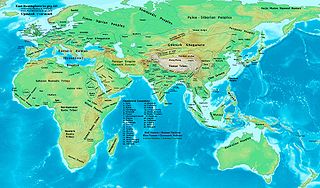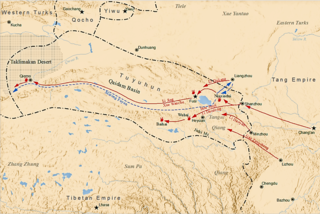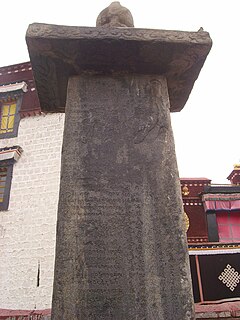| Murong Nuohebo | |||||||||
| Traditional Chinese | 慕容諾曷鉢 | ||||||||
|---|---|---|---|---|---|---|---|---|---|
| Simplified Chinese | 慕容诺曷鉢 | ||||||||
| |||||||||
| Wudiyebaledou Khan | |||||||||
| Traditional Chinese | 烏地也拔勒豆 可汗 | ||||||||
| Simplified Chinese | 乌地也拔勒豆 可汗 | ||||||||
| |||||||||
| Ledou Khan | |||||||||
| Chinese | 勒豆可汗 | ||||||||
| |||||||||
| Prince of Qinghai | |||||||||
| Chinese | 青海王 | ||||||||
| Literal meaning | ruler of Qinghai | ||||||||
| |||||||||
Murong Nuohebo (慕容諾曷鉢) (died 688), regal title Wudiyebaledou Khan (烏地也拔勒豆可汗) or, in short, Ledou Khan (勒豆可汗), Tang Dynasty noble title Prince of Qinghai (青海王), was the last khan of the Xianbei state Tuyuhun. He had become khan in 635 after his grandfather, the Busabo Khan Murong Fuyun and his father, the Gandou Khan Murong Shun, had both been killed in the same year: Murong Fuyun during a Tang invasion and Murong Shun assassinated by his own people in the aftermaths of the Tang conquest. Murong Nuohebo's control over his people was initially tenuous and required Tang military affirmation on at least two occasions, but once his control was firmer, he faced the threat of Tibetan Empire to the south-west. In 663, unable to stand Tibet pressure, he took his people and requested refuge in Tang territory, and by 672, Tibet had taken over all of former Tuyuhun territory. The Tuyuhun people were settled within Tang territory, and Murong Nuohebo was made a Tang prefect. While he continued to carry the title of khan until his death in 688, typically, Tuyuhun was considered destroyed by either 663 or 672.
Khan is a title of unknown origin for a ruler or military leader. It first appears among the Göktürks as a variant of khagan and implied a subordinate ruler. In the Seljuk Empire it was the highest noble title, ranking above malik (king) and emir. In the Mongol Empire it signified the ruler of a horde (ulus), while the ruler of all the Mongols was the khagan or great khan. The title subsequently declined in importance. In Safavid Persia it was the title of a provincial governor, and in Mughal India it was a high noble rank restricted to courtiers. After the downfall of the Mughals it was used promiscuously and became a surname.

The Xianbei were an ancient nomadic people that once resided in the eastern Eurasian steppes in what is today Mongolia, Inner Mongolia, and Northeast China. They originated from the Donghu people who splintered into the Wuhuan and Xianbei when they were defeated by the Xiongnu at the end of the 3rd century BC. The Xianbei were largely subordinate to larger nomadic powers and the Han dynasty until they gained prominence in 87 AD by killing the Xiongnu chanyu Youliu. However unlike the Xiongnu, the Xianbei political structure lacked the organization to pose a concerted challenge to the Chinese for most of their time as a nomadic people. After suffering several defeats by the end of the Three Kingdoms period, the Xianbei migrated south and settled in close proximity to Chinese society. As one of the Five Barbarians, they took part in the Uprising of the Five Barbarians and founded their own states in China such as the Northern Wei. These states opposed and promoted sinicization at one point or another but trended towards the latter and had merged with the general Chinese population by the Tang dynasty.
Murong Fuyun (慕容伏允) (597–635), formal title Busabo Khan (步薩鉢可汗), was a ruler of the Xianbei state Tuyuhun. He first became ruler when his brother Murong Shifu was assassinated in 597, and became one of the longest-ruling monarchs in Tuyuhun history. During his reign, he had major conflicts with China's Sui Dynasty and Tang Dynasty, and in 635, during a Tang invasion, he was assassinated due to the people's resentment of his hostile attitude toward Emperor Taizong of Tang that led to the invasion.
















